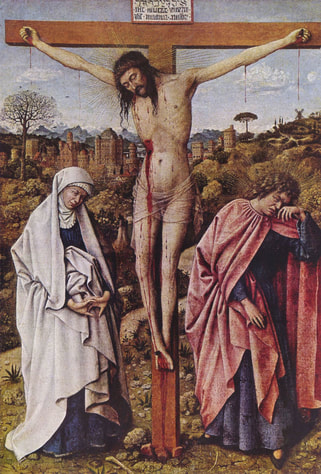 John 19:25b-27 Jesus said to the disciple whom he loved, ‘Here is your mother.’ And from that hour the disciple took her into his own home. (John 19:27). Mothering Sunday has a long tradition according to which the faithful would visit on this day their mother church – the parish church where they had been Baptised and received as sons and daughters of the whole Church of God. Today this tradition has largely been forgotten and the focus of the celebrations has shifted from the Church to motherly love in all its forms. Our gospel reading invites us to turn our attention towards Calvary to help us in finding the best pattern of motherly love in the most unlikely of places. As we look at the crucifixion scene we find the greatest example of motherhood in Mary, and, recapitulated in the Blessed Virgin, we also find all the unconventional mothers listed in the Scriptures. These are women who loved their children with boundless affection and trusted in God without any reserve. Among these remarkable women we find Sarah the mother of Isaac, Jochebed the mother of Moses, Hannah the mother of Samuel, and Naomi, Ruth’s mother-in-law. But if Mary is the best example of motherhood, why do our readings focus on such a terrible moment? Why do we have to look for a model of motherhood in such a desolated place as Calvary? Well, because it is in this place, at the foot of the Cross, that Mary is given by Jesus as “the” mother-figure for all people – not at Bethlehem, not at Nazareth or in the Temple, but on Calvary. At first, the whole scene may seem a little distant to our society that mainly associates pretty flowers, jewellery, and pastel colours for “Mother’s Day”. Mary is a widow whose Son has been condemned as an outlaw. Sharing in her son’s pain as only a mother can, she stays by the Cross, refusing to abandon Jesus. Her Son’s friends, many of whom she knew well, have all left apart from the youngest of them – John is little more than a youth. The adoring crowds who often stood between her and Jesus have gone as well. Those who are left do not care for her; they are there to bully her Son, to taunt Jesus even as He hangs from the Cross. Mary finds herself powerless, speechless at the impending, painful, undignified death of her only Son; her immaculate heart is broken, pierced just as Simeon had predicted when she presented Jesus to the Temple. But there is more, in these tragic moments Mary’ social position becomes even more precarious in a society that cared nothing or very little for women without male relatives. At the foot of the Cross, Mary knows that, once Jesus will draw his last breath she will find herself to be a nobody for ancient society. So, yes. Mary at the Cross does not exemplify motherhood in the most conventional, soft, and rosy sense we are so used to. But as we look closely at this scene, we can find faint echoes of it throughout history, even in our days; women whose love for their children is shown more often through the courage of their actions than through displays of affection; women doing all that is within their powers to be with their children no matter what the circumstances may be; and again women whose social position is determined only by whom they marry or who their sons are. As we look closely at this scene then we see that the challenging model of motherhood expressed on Calvary is able to speak to us all today too. But we ought to go a little further than this in looking at Mary’s motherhood, because even in this moment all is not lost. Mary may feel devastated and forsaken as she watches her Son. Yet, in this moment of absolute desperation, Mary’s motherhood is changed for good. As Mary feels that in losing her son she has become useless, God still sees her indispensable. In this profoundly dark night of her soul Mary receives from Jesus a new motherhood, the gift of a new son. John becomes her son, and with him Mary receives all followers of Christ in her care and embrace. At Calvary Mary is given as a gift, to all believers. So today, as we think with affection and gratitude about our own mothers and all the mother-figures we have encountered, the Church invites us to do a twofold task; to take Mary in our homes as our Mother as John did, and also to pray for those mothers who, like Mary, find themselves in difficult, painful situations. Today and everyday may we hear Jesus saying to us, Here is your mother (John 19:27). Amen.
0 Comments
Your comment will be posted after it is approved.
Leave a Reply. |
Archives
June 2020
Categories
All
|
 RSS Feed
RSS Feed


